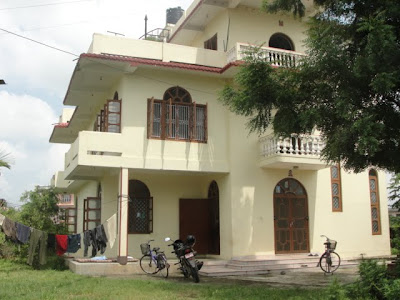The Murry Foundation English School is a sort of boarding school/orphanage serving about 90 kids who are more or less orphaned because at least one parent has been maimed or killed by a wild animal. Most have aunts and uncles or other family that they go home to at festival time in the autumn, but some have no one at all. There are a few adults who live there with them--cooks and people who mind their limited livestock--but not at a ratio that gives any of them the kind of attention or support most of us experience growing up. Also present are a couple of cows and buffalo and a bunch of those lop-eared goats who wander around grazing, climbing anything they can climb and meandering the dining hall to nibble on food scraps, corn husks and table legs. Besides the school (which also houses their severely overcrowded sleeping quarters,) there are outbuildings for toilets and showers and a large kitchen/dining hall. From any point on the south side of their land, you can look across a broad field of rice paddies to the edge of the jungle that stretches all the way to India.
On rainy Saturdays, a lot of the kids pour into one end of the dining hall and watch bad Indian TV on a station I have heard is owned by Fox. I think they have some movies and a DVD player too, but they don't have the basic patch cable to use it. I usually try to bring something with me, like paper and crayons, but often it is the things I have with me all the time that they are most interested in, like sunglasses, an umbrella, or, of course, my camera. They love taking pictures, and they love having their pictures taken, but there are always a few kids who snatch it away from the less powerful ones when I am not looking, or who weasel their way into four out of every five pictures taken.
Sometimes this job is extremely difficult. It can be hard to motivate kids who have no parents to push them, to encourage them, to reward them or to discipline them. It is difficult to teach in an environment where materials are so lacking and the things they do have are grossly inadequate. I know they have more here than a lot of kids have--a roof over their heads, two meals a day, an education--but it is still so hard to see them go without.
At the end of the day, the most I can do is to give them my best effort in class and my time and attention out of class, where I can play chase games and tickle monster with the little ones and give them piggy-back rides and just scoop them up so they can sit on a lap and be bounced a bit. It is amazing and endlessly inspiring to me how their little faces light up from these simple pleasures, their laughter echoing, amplified in a cavernous empty room.
























































